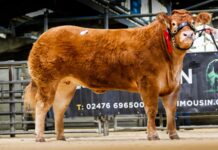The British Limousin Cattle Society (BLCS) has commenced a further research initiative that will develop new genomic breeding values for Female Fertility and Calf Survival in Limousin cattle. The announcement was made at the NBA’s 2016 Beef Expo held at Bakewell Mart, Derbyshire.
The title of this new project is ‘Improvement of Female Fertility and Calf Survival in the UK Beef Industry’ and is a further strand of the Society’s ten-year-Breed Improvement Plan. This latest work is in partnership with SRUC (Scotland’s Rural College) and is being funded jointly by Innovate UK and BBSRC. Having commenced in April 2016 it will last for 12 months, whereupon the outcomes will be:
- Use of BCMS records to improve the volume and integrity of Limousin records for fertility genetic evaluation
- Investigation in to and development – if possible – of a new breeding value for Calf Survival to weaning.
- Production of new Genomic Breeding Values for the fertility and survival traits
If successful, British Limousin will be the only beef breed in the UK to deliver a Calf Survival breeding value to its customers. For each 1% of calves lost in a herd, it is known that the gross margin return can reduce by around 6-8%. The benefit of being able to identify bulls whose calves have better rates of survival is therefore considerable and will, the Society expects, gives very good reason for producers to further invest in Limousin cattle.

Work has already started and the BCMS database is yielding some interesting early findings. In comparison to the next most popular breeds of suckler cow throughout Britain, Limousin-bred sucklers have…
- a 5% lower heifer replacement rate
- 2% higher Longevity at 8 years of age
- up to 1.5% lower Calf Mortality nationwide
This information will form the basis of the eventual genetic analysis. Commenting BLCS Technical Manager Alison Glasgow said: “Along with the ongoing Feed Efficiency project and establishment of Genomic Breeding Values for VIA Carcase Traits, the work will complete three main breeding strands of the 10-Year Breed Improvement Plan which was rolled out in late 2014. In combination, these complementary areas of development are of significant relevance to industry providing the genetics that will excel in ever-changing production and trading environments.”



















